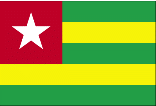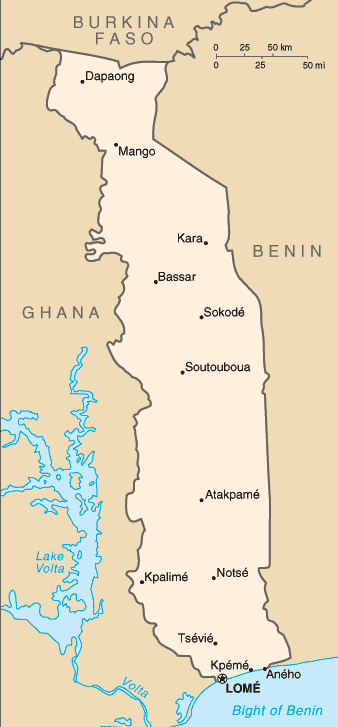|
Togo
|

|
Capital: Lome
Population: 8,082,366
Brief History of Togo:
The land that is now the country of Togo was inhabited by the Ewe tribal people starting in the 12th century. The first Europeans to arrive were the Portuguese in the 15th century. The area became a major part of the slave trade with the coast of Togo being part of the Slave Coast.
In 1884, Togo became a German colony. It was one of Germany's best colonies as it was Germany's only self-supporting colony. In 1914, France and Britain invaded and France took control of the country. In 1957 Togoland joined with the Gold Coast to become the independent country of Ghana. French Togoland became a separate republic a few years later and became Togo in 1960. The first ruler of Togo was General Gnassingbe Eyadema. He ruled as dictator for almost 40 years.
The Geography of Togo
Total Size: 56,785 square km
Size Comparison: slightly smaller than West Virginia
Geographical Coordinates: 8 00 N, 1 10 E
World Region or Continent: Africa
General Terrain: gently rolling savanna in north; central hills; southern plateau; low coastal plain with extensive lagoons and marshes
Geographical Low Point: Atlantic Ocean 0 m
Geographical High Point: Mont Agou 986 m
Climate: tropical; hot, humid in south; semiarid in north
Major cities: LOME (capital) 1.593 million (2009)
The People of Togo
Type of Government: republic under transition to multiparty democratic rule
Languages Spoken: French (official and the language of commerce), Ewe and Mina (the two major African languages in the south), Kabye (sometimes spelled Kabiye) and Dagomba (the two major African languages in the north)
Independence: 27 April 1960 (from French-administered UN trusteeship)
National Holiday: Independence Day, 27 April (1960)
Nationality: Togolese (singular and plural)
Religions: indigenous beliefs 51%, Christian 29%, Muslim 20%
National Symbol:
National Anthem or Song: Salut a toi, pays de nos aieux (Hail to Thee, Land of Our Forefathers)
Economy of Togo
Major Industries: phosphate mining, agricultural processing, cement, handicrafts, textiles, beverages
Agricultural Products: coffee, cocoa, cotton, yams, cassava (tapioca), corn, beans, rice, millet, sorghum; livestock; fish
Natural Resources: phosphates, limestone, marble, arable land
Major Exports: reexports, cotton, phosphates, coffee, cocoa
Major Imports: machinery and equipment, foodstuffs, petroleum products
Currency: Communaute Financiere Africaine franc (XOF); note - responsible authority is the Central Bank of the
National GDP: $6,464,000,000
** Source for population (2012 est.) and GDP (2011 est.) is CIA World Factbook.
Back to Geography Home Page
